
Copyright: CC0 1.0
Editor: This is Hans Holbein the Younger's "The Fall of the Dragon," currently residing at the Harvard Art Museums. It's incredibly detailed, and the contrast between the knights and the chaotic dragon is striking. What do you make of the imagery presented here? Curator: Holbein positions the dragon and its demise as an ideological conflict. The knights, symbols of established power, violently overthrow the dragon, which may represent societal upheaval or perhaps religious heresy, depending on the political climate in which the work was viewed. Editor: So the dragon's fall isn't just a monster being defeated, but a statement on power? Curator: Precisely. Consider how such imagery might be used to reinforce existing power structures or to warn against dissent. Visual rhetoric matters. Editor: That gives me a lot to consider about the artwork's intention. Thank you. Curator: My pleasure. It highlights how art serves not merely as decoration but also as a potent tool for social messaging.
Comments
No comments
Be the first to comment and join the conversation on the ultimate creative platform.













